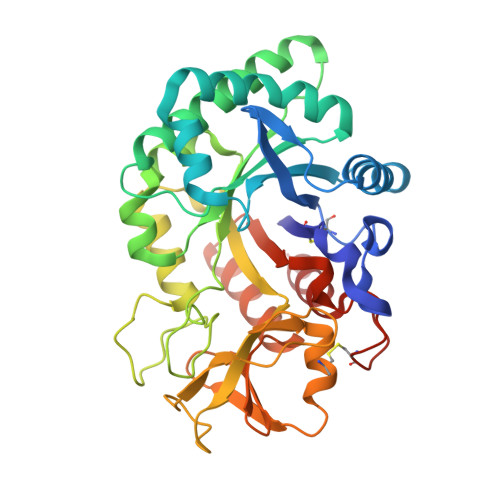Crystal structure of a secretory signalling glycoprotein from sheep at 2.0A resolution
Srivastava, D.B., Ethayathulla, A.S., Kumar, J., Singh, N., Sharma, S., Das, U., Srinivasan, A., Singh, T.P.(2006) J Struct Biol 156: 505-516
- PubMed: 16859926
- DOI: https://doi.org/10.1016/j.jsb.2006.05.008
- Primary Citation of Related Structures:
2DPE - PubMed Abstract:
A 40kDa glycoprotein from dry secretion of sheep is implicated as a signaling factor and is named as SPS-40. This protein is secreted only during the early phase of involution when the drastic tissue remodeling occurs in the mammary gland. SPS-40 was purified from sheep dry secretions and crystallized using hanging drop vapour diffusion method. The crystals belong to orthorhombic space group P2(1)2(1)2(1) with cell dimensions, a=62.7A, b=66.4A, c=107.5A. The protein was also cloned for the determination of its complete amino acid sequence. The three-dimensional structure of SPS-40 was determined by X-ray crystallographic method at 2.0A resolution. The structure revealed the presence of an N-linked glycan chain at Asn39. The protein adopts a conformation with a classical (beta/alpha)(8)-barrel fold of triosephosphate isomerase (TIM) (residues 1-237 and 310-360) with an insertion of a small (alpha+beta) domain (residues 240-307) similar to that observed in chitinases. However, the Leu substitution for Glu in the consensus catalytic sequence in SPS-40 causes a loss of chitinase activity. Furthermore, the sugar-binding groove in SPS-40 is distorted considerably from the standard chitin-binding site in chitinase enzymes and hence the binding of chitin-like oligosaccharides is considerably hampered. Three surface loops, His188-His197, Phe202-Arg212 and Phe244-Pro260 have exceptionally high values of B-factors (average=70.5A(2)), indicating the presence of a less defined region.
- Department of Biophysics, All India Institute of Medical Sciences, Ansari Nagar, New Delhi 110029, India.
Organizational Affiliation:

















